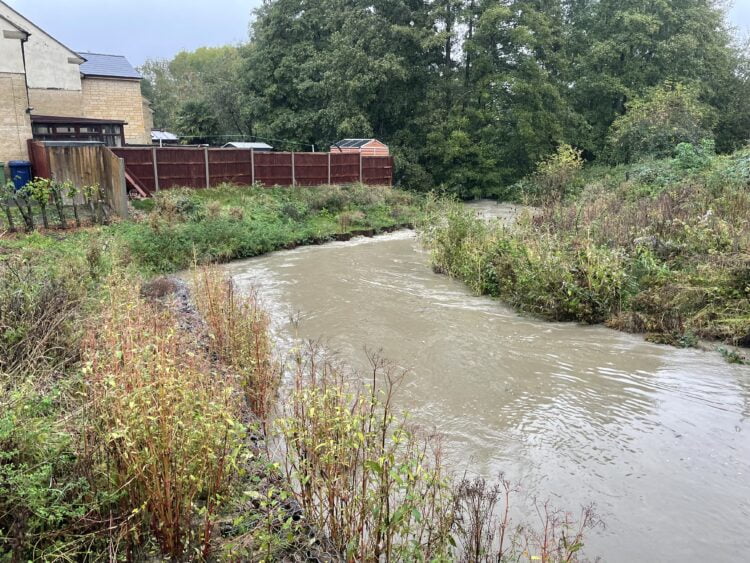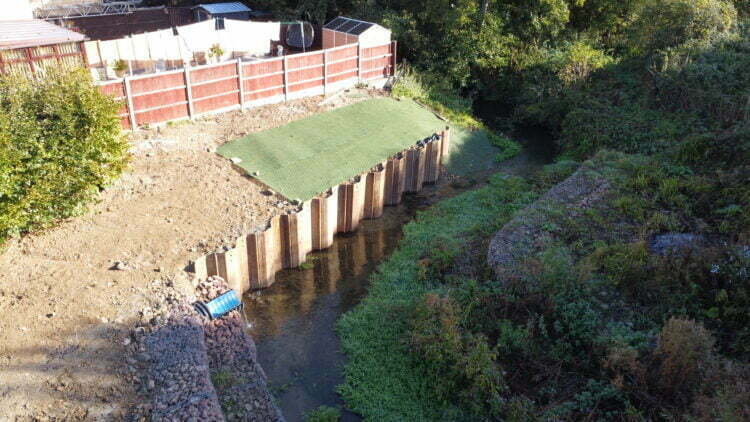The Gloucestershire Warwickshire Steam Railway (GWSR) reports that its river works have proved effective against flooding during recent bouts of heavy rainfall.
The River Isbourne flows beneath the high railway embankment on the GWSR route out of Winchcombe station towards Broadway. Recent civil engineering works have strengthened the embankment. The work was carried out through two separate contracts, correcting erosion that had been developing on the bank and mitigating the risk of flooding.

GWSR believes that its efforts have been vindicated as the river, which rises on the northern edge of Cleeve Hill and runs fourteen miles (22km) to the River Avon near Hampton, Worcestershire, has carried a large volume of water over recent weeks without flooding.
The work improved the flow of the river, and was carried out by the company Walsh Construction, which has also been contracted to repair the railway’s enormous Stanway Viaduct. The improvements have eliminated the risk of erosion to the railway embankment, which, if it had not been addressed, could have led to problems with the stability of the embankment.

GWSR has successfully concluded this year’s normal running season, and is now preparing for its Santa Specials, which run between Cheltenham Racecourse and the North Pole (aka Winchcombe). Father Christmas and his army of volunteer helpers will offer a warm welcome to all visitors, who can buy their tickets here.
Ian Scholey, the GWSR’s Infrastructure Manager and a professional civil engineer, explained: “This is an area with a history of flooding, which has caused erosion of the banks at the foot of the railway embankment and an increasing risk of damaging the railway embankment itself. In addition, deposits of gravel had formed an island on the upstream side of the bridge, interrupting the flow of water.
“Walsh installed steel sheet pile walls to contain the river, as well as gabions (stone filled cages), not only to protect the embankment but nearby properties as well.
“The work has taken some time to complete as it was interrupted by both the need to carry out works elsewhere on the railway as well as Covid and flooding in 2020 which emphasised the need for the river work to be completed as a matter of urgency.
“Recent heavy rain in the aftermath of Storm Babet – which fortunately was not as severe as elsewhere in the country – has vindicated this work and gives me confidence that the works will also cope with the aftermath of Storm Ciarán. The river, which carries runoff from the Cotswold hills was over a metre and a half higher than its normal level, yet it flowed unimpeded beneath the bridge that carries the railway, causing no damage to the river banks or surrounding property.
“I have no doubt that without the work that has been done, the storm river flow would have caused extensive damage on both sides of the railway embankment.”
Dr Graham Plant, the railway’s civil engineering director added: “Operating beautifully restored steam and heritage diesel locomotives and rolling stock is of course a key reason why visitors are attracted to our railway. But this is only a small part of running our wonderful heritage railway for the benefit of the public.
“With some 60 culverts, bridges and an aqueduct taking water across 14-mile (22km) line, drainage is a vital aspect of maintaining the integrity of the railway. The bridge over the River Isbourne is, at 13 feet (4m) high and 16ft 6in (5m) wide, the largest of these structures. The work completed here will help secure the railway for future decades.”





Responses